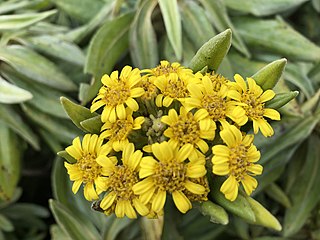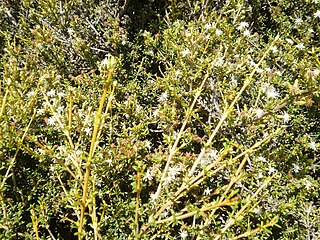
Olearia, most commonly known as daisy-bush, is a genus of flowering plants belonging to the family Asteraceae, the largest of the flowering plant families in the world. Olearia are found in Australia, New Guinea and New Zealand. The genus includes herbaceous plants, shrubs and small trees. The latter are unusual among the Asteraceae and are called tree daisies in New Zealand. All bear the familiar daisy-like composite flowerheads in white, pink, mauve or purple.
The flora of the Chatham Islands consists of around 388 terrestrial plant species, of which 47 are endemic. The Chatham Islands make up the Chatham floristic province of the Neozeylandic Region of the Antarctic Kingdom.

The Chatham penguin, also known as the Chatham crested penguin, Chatham Islands penguin, or Warham's penguin, is an extinct species of crested penguin previously endemic to the Chatham Islands of New Zealand. It is known only from subfossil bones and probably became extinct within 150–200 years after Polynesians arrived in the Chatham Islands around 1500 CE.

Brachyglottis huntii, commonly called rautini or Chatham Island Christmas tree, is a species of flowering plant in the family Asteraceae. It is found only on the Chatham Islands in New Zealand.

Olearia hectorii is a species of flowering plant in the daisy family Asteraceae. Its common names include deciduous tree daisy and Hector's tree daisy. It is endemic to New Zealand, where it is nationally endangered.

Olearia traversiorum, the Chatham Island akeake, or Chatham Island tree daisy, is a species of flowering plant in the family Asteraceae. It is endemic to the Chatham Islands of New Zealand. It is also known by the synonym O. traversii.

Leptinella is a genus of alpine flowering plant in the family Asteraceae, comprising 33 species, distributed in New Guinea, Australia, New Zealand, South Africa, and South America. Many of the species are endemic to New Zealand.

Olearia macrodonta is a small sub-alpine evergreen tree endemic to New Zealand, from the plant family Asteraceae. It is closely related to the narrow-leaved Olearia ilicifolia, with which it shares several characteristics including largely undulating and serrated grey-green leaves. These common characteristics mean the two species are often confused with one another. It is found in lowland to sub-alpine forests from the East Cape of the North Island of New Zealand southwards throughout the South Island and Stewart Island, at 450–1,200 metres (1,480–3,940 ft) in altitude.

Olearia arborescens, also known as common tree daisy and pekapeka by Māori, is a common shrub or small tree of New Zealand. It has also been called the Glossy Tree Daisy and the Forest Tree Daisy. It grows in lowland to alpine scrubland in the North Island from East Cape southwards, and throughout the South and Stewart Islands. Olearia arborescens was previously known as Solidago arborescens.

Olearia odorata, the scented tree daisy, is a small divaricating shrub endemic to New Zealand, from the plant family Asteraceae. It has small light green leaves with a large amount of interlacing twigs and grows to around 2–4m in height. In spring O. odorata produces many small white flowers.

Pasiphila cotinaea is a species of moth in the family Geometridae. It is endemic to New Zealand. Its larvae feed off Olearia species and the adult moth can be seen on the wing from November to April. This species is regarded as rare.

Olearia solandri, commonly known as coastal daisy-bush or coastal tree daisy, is a coastal shrub of New Zealand in the Asteraceae family.

Pachystegia is a genus of shrubs in the family Asteraceae, known as Marlborough rock daisies, with distinctive leathery leaves and daisy-like flowers. They are naturally found only in dry areas of the north-eastern South Island of New Zealand.

Eudonia sabulosella is a species of moth in the family Crambidae. This species is endemic to New Zealand and is regarded as being common. The larvae of this species are known to damage pasture in New Zealand.
Imber's petrel is an extinct seabird of gadfly petrel from the Chatham Islands. The species' epithet commemorates New Zealand ornithologist Mike Imber (1940–2011).
Olearia adenocarpa or small-leaved tree daisy is a small divaricating shrub endemic to New Zealand, from the plant family Asteraceae. The bush grows up to 1.5 metres in height and 1.2 m wide. It has a smaller and open growth habit in comparison to Olearia odorata. It is trailing deciduous to semi-deciduous.

Olearia avicenniifolia, known commonly as mountain akeake, is a flowering plant in the family Asteraceae. It is endemic to New Zealand where it is found on the southern coastlines of the South Island and on Stewart Island. It is classified as Not Threatened.

Dracophyllum arboreum, commonly known as Chatham Island grass tree and tarahinau (Moriori), is a species of tree in the heath family Ericaceae. Endemic to the Chatham Islands of New Zealand, it reaches a height of 18 m (60 ft) and has leaves that differ between the juvenile and adult forms.

Megaherbs are a group of herbaceous wildflowers growing in the New Zealand subantarctic islands and on the other subantarctic islands. They are characterised by their great size, with huge leaves and very large and often unusually coloured flowers, which have evolved as an adaptation to the harsh weather conditions on the islands. They suffer from overgrazing due to introduced mammals.















